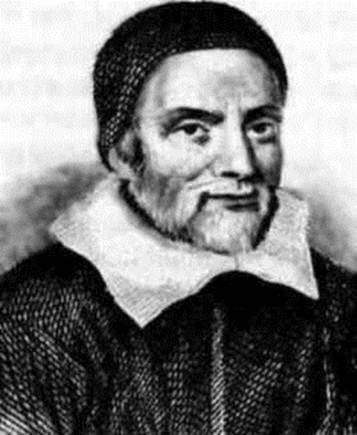
William Oughtred
 المؤلف:
F Cajori
المؤلف:
F Cajori
 المصدر:
William Oughtred, a Great Seventeenth Cenrury Teacher of Mathematics
المصدر:
William Oughtred, a Great Seventeenth Cenrury Teacher of Mathematics
 الجزء والصفحة:
...
الجزء والصفحة:
...
 17-1-2016
17-1-2016
 2108
2108
Born: 5 March 1574 in Eton, Buckinghamshire, England
Died: 30 June 1660 in Albury, Surrey, England

William Oughtred attended Eton School, which although a very famous school was in fact his local school. From there he went to King's College Cambridge, entering in 1592. Three years later he became a Fellow of King's College, received his B.A. in 1596 and his M.A. in the year 1600. It is surprising that although very little mathematics was taught at either Eton or Cambridge at this time Oughtred became passionately interested. He wrote:-
... the time which over and above those usuall studies I employed upon the mathematicall sciences I redeemed night by night from my naturall sleep, defrauding my body, and inuring it to watching, cold, and labour, while most others tooke their rest.
Oughtred was ordained an Episcopal minister in 1603. In 1604 he became vicar of Shalford and later, in 1610, he became rector of Albury.
Oughtred took private pupils who came to his house and lived there free of charge while they received mathematical instruction. He had many pupils but the most famous were John Wallis, Christopher Wren and Richard Delamain.
Aubrey [5] gives an interesting description of Oughtred's appearance and lifestyle:-
He was a little man, had black haire, and blacke eies (with a great deal of spirit). His head was always working. He would draw lines and diagrams on the dust.... he used to lye a bed till eleaven or twelve a clock, with his doublet on ... studyed late at night, went not to bed till 11 a clock, had his tinder box by him, and on top of his bed-staffe, he had his inke-horne fixed. He slept but little. Sometimes he went not to bed in two or three nights, and would not come downe to meales till he had found out the quaesitum.
Oughtred's most important work, Clavis Mathematicae (1631), included a description of Hindu-Arabic notation and decimal fractions and a considerable section on algebra. He experimented with many new symbols including × for multiplication and :: for proportion. Like all Oughtred's works it was very condensed containing only 88 pages.
Oughtred used π in Clavis Mathematicae but not for the ratio of the circumference to the diameter, merely for the circumference. Other notation for greater than and less than proved hard to remember and were not accepted, the familiar > and < being due to Harriot at almost the same time.
Oughtred is best known for his invention of an early form of the slide rule. Edmund Gunter (1620) plotted a logarithmic scale along a single straight two foot long ruler. He added and subtracted lengths by using a pair of dividers, operations that were equivalent to multiplying and dividing. In 1630 Oughtred invented a circular slide rule. In 1632 he used two Gunter rulers so that he could do away with the dividers. He published Circles of Proportion and the Horizontal Instrument in 1632 describing slide rules and sundials.
There was a dispute however regarding priority over the invention of the circular slide rule. Delamain certainly published a description of a circular slide rule before Oughtred. His Grammelogia, or the Mathematicall ring was published in 1630. It may well be that both invented this instrument independently. Unfortunately a very heated argument ensued and to some extent this formed a cloud over the later years of Oughtred's life.
The present form of the slide rule was designed in 1850 by a French army officer, Amedee Mannheim.
Oughtred's other works were Trigonometrie (1657), one of the first works on trigonometry to use concise symbolism, and a number of more minor works on watchmaking, solving spherical triangles by the planisphere and methods to determine the position of the sun.
- J F Scott, Biography in Dictionary of Scientific Biography (New York 1970-1990).
http://www.encyclopedia.com/topic/William_Oughtred.aspx#2
- Biography in Encyclopaedia Britannica.
http://www.britannica.com/eb/article-9057717/William-Oughtred
Books:
- F Cajori, William Oughtred, a Great Seventeenth Cenrury Teacher of Mathematics (Chicago-London, 1916).
- E Thacher, The slide rule (Palo Alto, 1995).
Articles:
- J Aubrey, William Oughtred, Brief lives II (Oxford, 1898), 106-110.
- T F Nikonova, The life and work of the English mathematician William Oughtred (Russian), Moskov. Oblast. Ped. Inst. Ucen. Zap. 240 (1969), 303-319.
- D Stander, Makers of modern mathematics : William Oughtred, Bull. Inst. Math. Appl. 23 (3-5) (1987), 72-73.
- J A Steadall, Ariadne's Thread: The life and times of Oughtred's Clavis, Annals of Science 57 (2000),27-60.
- A J Turner, William Oughtred, Richard Delamain and the Horizontral Instrument in Seventeenth Century England, Annali dell'Istituto e Museo di Storia delle Scienze, Firenze 6.2 (1981), 99-125.
 الاكثر قراءة في 1500to1599
الاكثر قراءة في 1500to1599
 اخر الاخبار
اخر الاخبار
اخبار العتبة العباسية المقدسة


